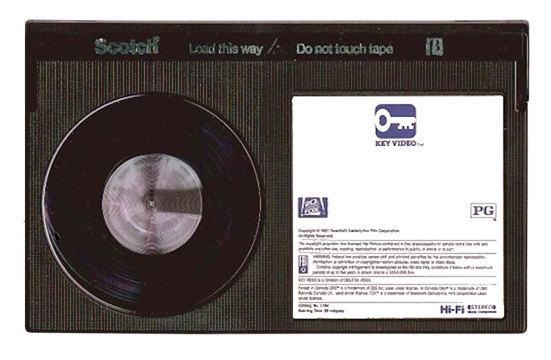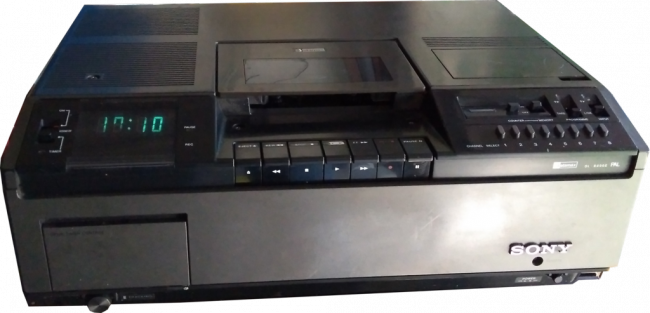
A Betamax video tape
On May 10, 1975, Sony released a consumer-level analog videocassette magnetic tape recording format called Betamax. Today, the format is obsolete, having lost the videotape format war to VHS with Betamax recorders ceased production in 2002.
A Brief History of Video Recording
The first efforts at video recording, using recorders similar to audio recorders with fixed heads, were unsuccessful. The problem was that a video signal has a much wider bandwidth than an audio signal (6 MHz vs 20 kHz), requiring extremely high tape speeds to record it. One of the first efforts was the Vision Electronic Recording Apparatus, a high speed multi-track machine developed by the BBC in 1952 using a thin steel tape traveling at over 500cm per second. It became clear a practical video recording technology depended on finding some way of recording the wide-bandwidth video signal without the high tape speed required by linear-scan machines. The solution was the transverse-scan technology invented by Ampex around 1954, in which the recording heads are mounted on a spinning drum and record tracks in the transverse direction, across the tape.
From Video Tape to Video Cassette
Thus, the first practical video tape recorder, using transverse tape head scanning, was developed by Ampex Corporation in 1956. The early VTRs were reel to reel devices which recorded on individual reels of 2 inch (5.08 cm) wide magnetic tape. They were used in television studios, serving as a replacement for motion picture film stock and making recording for television applications cheaper and quicker. Beginning in 1963, videotape machines made instant replay during televised sporting events possible. Improved formats, in which the tape was contained inside a videocassette, were introduced around 1969.
The Sony U-Matic System
Sony demonstrated a videocassette prototype in October 1969, then set it aside to work out an industry standard by March 1970 with seven fellow manufacturers. The result, the Sony U-matic system, introduced in Tokyo in September 1971, was the world’s first commercial videocassette format. U-matic, with its ease of use, quickly made other consumer videotape systems obsolete in Japan and North America, where U-matic VCRs were widely used by television newsrooms, schools and businesses. But the high cost – US$1,395 in 1971 for a combination TV/VCR, equivalent to over $8000 in 2014 dollars – kept it out of most homes.
Betamax for the Consumers
This should change with the arrival of Sony’s consumer-level analog videocassette magnetic tape recording format called Betamax, released in Japan on May 10, 1975. The video cassettes contain .50 in (12.7 mm)-wide videotape in a design similar to the earlier, professional U-matic format. Like the rival videotape format VHS (Video Home System, introduced in Japan by JVC in October 1976), Betamax had no guard band and used azimuth recording to reduce crosstalk. According to Sony’s own history webpages, the name came from a double meaning: beta being the Japanese word used to describe the way signals were recorded onto the tape, and from the fact that when the tape ran through the transport, it looked like the Greek letter beta (β).

Sony Betamax video recorder.
And then there was VHS
Sony had expected that other electronics manufacturers would back a single format for the good of all. But JVC in particular decided to go with its own format VHS, despite Sony’s appeal to the Japanese Ministry of Trade and Industry, thus beginning the so-called videotape format war. While VHS machines’ lower retail price was a major factor, the principal battleground proved to be recording time. The original Sony Betamax video recorder for the NTSC television system could only record for 60 minutes, identical to the previous U-matic format, which had been sufficient for use in television studios. JVC’s VHS could manage 120 minutes, followed by RCA’s entrance into the market with a 240 minute recorder. These challenges sparked a mini-war to see who could achieve the longest recording time. On the other hand, Betamax offered a slightly higher horizontal resolution (250 lines vs 240 lines horizontal NTSC), lower video noise, and less luma/chroma crosstalk than VHS, and was later marketed as providing pictures superior to VHS’s playback.
Market Dominance
But the main determining factor between Betamax and VHS should be the cost of the recorders and recording time. By the time Sony made changes according to a longer recording time to their strategy, VHS dominated the market, with Betamax relegated to a niche position. Beta sales dwindled away and VHS emerged as the winner of the format war. In 1988, Sony began to market its own VHS machines, and, despite claims that Sony was still backing Beta, it was clear that the format was dead. In Japan, Betamax had more success and eventually evolved into Extended Definition Betamax, with 500+ lines of resolution, but eventually both Betamax and VHS were supplanted by laser-based technology. Betamax recorders ceased production in 2002, but the format’s cassette tapes were available until March 2016, when Sony discontinued them.
First Betamax – Salesman Training Video 1977, [6]
References and Further Reading:
- [1] Marc Wielage and Rod Woodcock: The Rise and Fall of Beta
- [2] Charles Riley: Sony is finally killing its ancient Betamax format, at money.cnn.com
- [3] The Great Format War of the early 1980s, at Total Recall
- [4] Betamax at Wikidata
- [5] The ‘Total Rewind’ VCR museum – covering Betamax and other vintage formats
- [6] First Betamax – Salesman Training Video 1977, TheHistoryofTV @ youtube
- [7] Timeline of Sony Products, via DBpedia and Wikidata






Pingback: Whewell’s Gazette: Year 3, Vol. #39 | Whewell's Ghost